Teodorescu P.P. Mechanical Systems, Classical Models Volume I: Particle Mechanics
Подождите немного. Документ загружается.

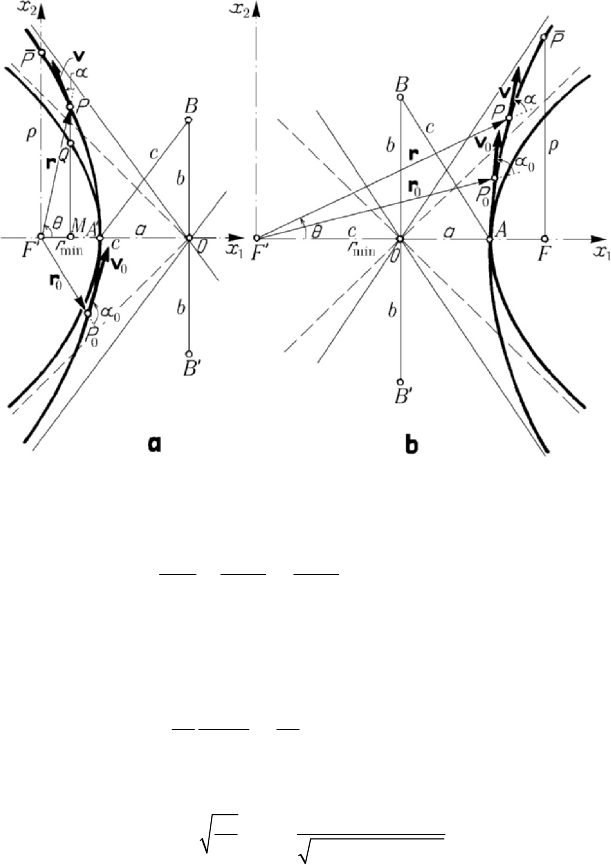
MECHANICAL SYSTEMS, CLASSICAL MODELS
572
the case in which
0k > the particle moves along the hyperbola branch which
surrounds the centre of attraction
F
′
(Fig.9.10,a), while, if 0k
<
, then the particle
moves along the other hyperbola branch (Fig.9.10,b); in each of the mentioned cases,
the other branch of the hyperbola leads to
0r
<
(as in the case in Fig.9.2,b). We notice
that
min
/(1 ) ( 1)rpeae c
=
+= −< for 0k > and
min
/( 1)rpe
=
− (1 )ae=+
c> if 0k
<
; the apsidal point is reached only once by the particle during the motion
along the trajectory. Taking into account (9.2.23'), it results the remarkable form (for
0k > )
Figure 9.10. Hyperbolic motion due to the potential () /Ur k r
=
.
Case
0k > (a); case 0k
<
(b).
2
22
mv fmM fmM
ra
−=
(9.2.23
iv
)
for the conservation theorem of mechanical energy.
The law of motion along a hyperbola branch is given by the equation (9.2.10). The
relations (9.1.1') and (9.2.23') allow to write (for
0k > )
2kah
=
,
()
2
222
2
22
1
1
hp h
Cae
mm
e
==−
−
,
min
(1)rae
=
− ,
wherefrom
0
222
(1)
d
2
()
r
ea
m
tt
h
aae
ρρ
ρ
−
=+
+−
∫
;
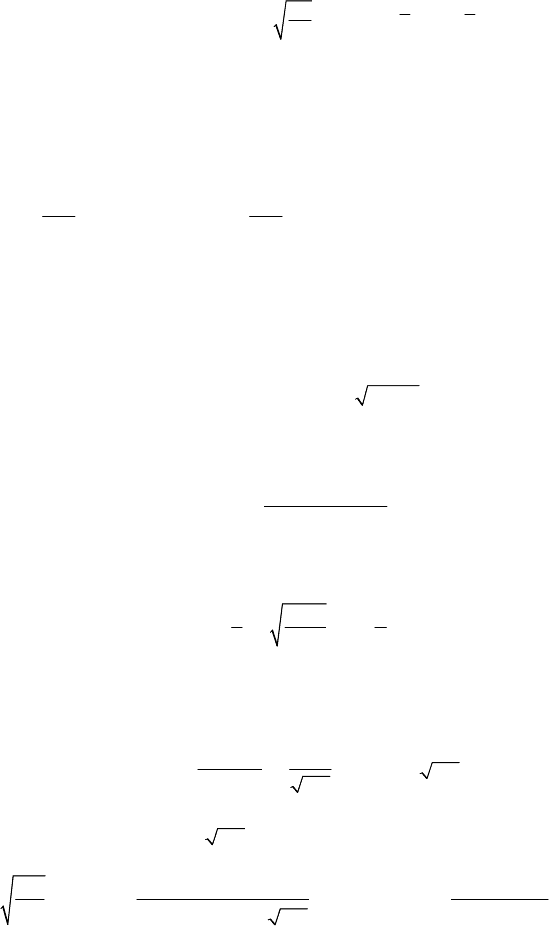
Newtonian theory of universal attraction
573
the change of variable
(cosh 1)ae uρ =− leads to
0
0
(cosh 1)d
2
u
m
tt a e u u
h
=+ −
∫
.
Finally, we obtain the equation
0
sinh ( )euuntt
−
=−,
(9.2.24)
analogous to Kepler’s one for the elliptic motion,
n being given by (9.2.17); in this
case, the parameter
(,)u
∈
−∞ ∞ corresponds to the parametric equations
1
coshxOM a u==−
,
2
sinhxMQa u==
of the rectangular hyperbola with the
same centre
O and the same semiaxis a (Fig.9.10,a). Taking into account the relations
(cosh 1)rae u=−, cosh cosaucrθ
=
−
(9.2.25)
and the equation of the hyperbola, we get the Cartesian co-ordinates (Fig.9.10,a)
1
(cosh)xae u=− ,
2
2
1sinhxae u=− .
(9.2.25')
It results
cosh
cos
(cosh 1)
ca u
ae u
θ
−
=
−
,
(9.2.25'')
wherefrom we obtain the relation between the angle
θ and the parameter u in the form
1
tan tanh
212
eu
e
θ +
=
−
.
(9.2.26)
One can use also the equation (9.2.16) to study the motion of the particle along the
trajectory; we have
0γ < , because 1e > . In this case
()
2
d
1
arg tanh
1
η
γη
γ
γη
=−
−
+
∫
;
by the change of variable
(
)
tanh /2uγη
−
= , we may write
()
()
0
32
3/2
2
11
( ) (sinh ) (sinh )
(1) 1
1
f
M
tt e uu e uu
pee
e
γ
−= −= −
+−−
−
,
obtaining thus an equation equivalent to the equation (9.2.24).
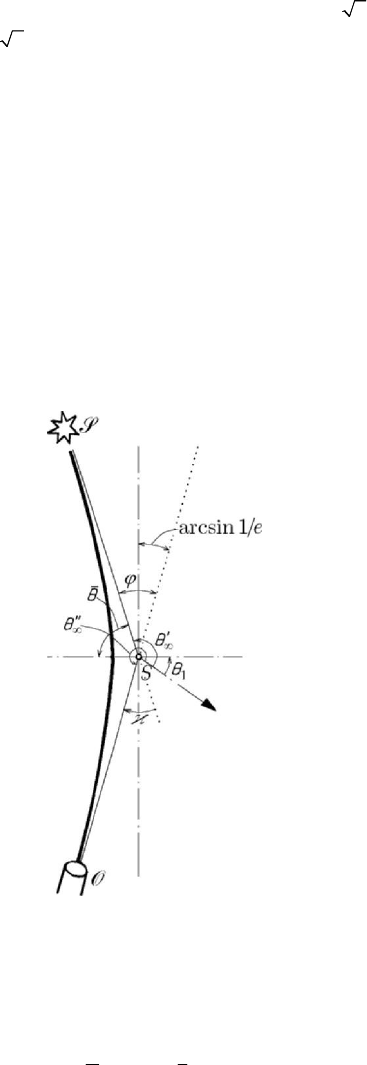
MECHANICAL SYSTEMS, CLASSICAL MODELS
574
In the particular motion on a rectangular hyperbola we have
2e
=
, so that pa= ,
while
()
(
)
()
tan /2 1 2 tanh / 2uθ =+ .
2.1.6 Deviation of the light ray
Starting from observations, it was stated that a light ray coming from a star
S far
off, its path passing in the vicinity of the Sun
S , is deviated; its final direction (for the
observer
O ) makes an angle ϕ with its first direction. We consider thus the trajectory
of a photon, assuming that this one, modelled as a particle, has a mass. The photon
describes a conic in its motion in the gravitational field of the Sun. Assuming that the
photon passes very close to the surface of the Sun (Fig.9.11), we may take
8
0
6.96 10 mr =⋅ , corresponding to Sun’s radius (any point of the trajectory may be
taken as initial position, in particular the apsidal point); as well,
8
0
310 m/sv =⋅ (the
velocity of light in vacuum), while
33
210 gM =⋅ (Sun’s mass). The inequality
2
00
2rv fM> is satisfied, so that the trajectory of the photon is an arc of hyperbola.
Figure 9.11. Deviation of the light ray.
From the equation (9.2.6) it results that the two asymptotes are specified by the
equation
1
1cos( )0e θθ+−=, which has always solutions, because
1e >
. The
angles
θ
∞
, corresponding to the two asymptotes, are given by
(
)
1
1
arcsin
2 e
π
θθ
∞
=± + ;
(9.2.27)

Newtonian theory of universal attraction
575
we may write (Fig.9.11)
1
1
arcsin
2 e
π
θθ
∞
′
=++
,
1
31
arcsin
2 e
π
θθ
∞
′′
=+ −
(9.2.27')
too. We notice that each asymptote makes an angle equal to
(
)
arcsin 1/ 1/ee≅ with
the imaginary axis of the hyperbola; hence, the angle made by the two asymptotes,
equal to the angle
ϕ , corresponding to the deviation of the light ray, is given by
12
2arcsin
ee
ϕ
=
≅ .
(9.2.27'')
However, this formula could be obtained also by using the results in Chap. 8, Subsec.
1.2.1 concerning the phenomenon of diffraction. In our case, the diffraction angle
(Fig.9.11) is given by
[
]
11
22()2()πθ π πθθ π θθ
∞∞
′′
=− + =− + − − = − −
;
from
(
)
1
sin /2 cos( ) 1/eθθ
∞
′
=−=−
it results 2/e
≅
−
, the angle of
diffraction being negative, because the centre
S (the Sun) is of attraction. We notice
that
ϕ=
.
Because at the apsis the velocity is normal to the radius vector (which starts from
S ), we have
0
/2απ= ; in this case, from (9.2.7') it results (e is of an order of
magnitude
6
10 )
22
00 00
1
rv rv
e
f
MfM
=−≅
.
(9.2.28)
We may write
2
00
2
f
M
rv
ϕ ≅
;
(9.2.28')
numerically, we obtain
0.87 sϕ ≅
.
Astronomical observations of great precision made during the total solar eclipses (for
the first time in May 1919), to may “catch” the light ray coming from the star
S, have
put in evidence a double angle (
1.74 sϕ
≅
), obtaining thus a new non-concordance of
the Newtonian model with the physical reality (besides the secular displacement of
Mercury’s perihelion, see Subsec. 2.1.4). However, one cannot be sure if these non-
concordances are due to Newton’s laws or to the Newtonian theory of gravitation (or to
both mathematical models); some direct improvements of those models did not lead to
convenient results, excepting the invariantive model built up by O. Onicescu (see Chap.
21, Sec. 3.2). These contradictions disappear in the frame of the general theory of
relativity elaborated by A. Einstein.

MECHANICAL SYSTEMS, CLASSICAL MODELS
576
2.1.7 Parabolic motion
If 0h = (we can have only 0k > , e.g., kfmM
=
), then the trajectory of a particle
acted upon by a Newtonian force of attraction is a parabola. Observing that
1e =
, the
equation (9.2.5') takes the form (Fig.9.12)
(
)
2
21
2
2
p
xpx=− −
(9.2.29)
in the parabolic motion; the distance to the pericentre is given by
Figure 9.12. Parabolic motion due to the potential () /Ur k r
=
.
22 2
2
00 0
min
sin
22 2
rv
pC
r
f
MfM
α
== =
.
(9.2.29')
The conservation theorem of mechanical energy takes the form
2
2
mv fmM
r
=
.
(9.2.30)
The formula (9.2.10) leads to
0
/2
d
2
/2
r
p
m
tt
k
p
ρρ
ρ
=+
−
∫
,
wherefrom we get
0
12
() /2
3
tt rprp
f
M
=+ + −
.
(9.2.31)
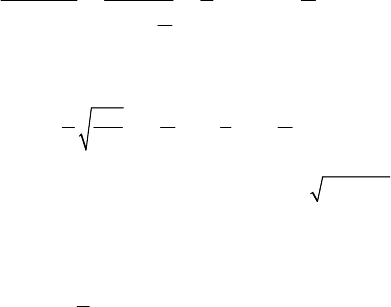
Newtonian theory of universal attraction
577
The equation (9.2.6) becomes (we consider the most general case in which
1
0θ ≠ and
use the true anomaly
1
ψθθ=−)
(
)
2
2
1tan
1cos 2 2
2cos
2
ppp
r
ψ
ψ
ψ
===+
+
,
(9.2.29'')
so that
(
)
2
0
1
tan 1 tan
2232
pp
tt
f
M
ψψ
=+ +
.
(9.2.31')
Starting from (9.2.9'), we obtain
()
23
1d2/d
f
Mp tηη+=
; observing that
(
)
tan /2ηψ= , we find again the above results. Using the co-ordinates
1
cosxrψ= ,
2
sinxrψ= , we get the Cartesian parametric equations of the trajectory
()
2
1
1
2
p
x η=−
,
2
xpη
=
.
(9.2.29''')
The equation (9.2.31') has only one real root
(
)
tan /2ψ for a given
t
. The moment
0
t
is obtained for
0t =
; if
0
0t
<
, then one cannot have 0ψ
=
, so that the particle
starts from the initial position and describes an arc of parabola towards infinity, without
passing through its vertex.
2.1.8 Motion of comets
Newton’s research has been extended also on the comets known at his time,
especially on the Halley comet, appeared in 1680; he assimilated thus the trajectories of
the comets to very elongated ellipses, to which Kepler’s laws may be applied. Based on
Halley’s observations, Newton concluded that in case of comets too we have
2
/constCp= , being thus led to the same law of universal attraction. Hence, the law
of motion is that obtained in Subsec. 2.1.2, and the motion of a comet may be also a
parabolic one; corresponding to the results of the preceding subsection, the Sun is at
one of the foci, as it was shown by Newton. The theorem of areas may be applied too.
The co-ordinates which specify the parabolic trajectory of a comet are
,, ,it
π
Ωω and
the perihelion distance
/2p , hence only five independent parameters.
2.2 Problem of artificial satellites of the Earth and of interplanetary
vehicles
Using the results obtained in the preceding subsection, we consider, in what follows,
the problem of the artificial satellites of the Earth and of the interplanetary vehicles; we
may thus put in evidence the cosmic velocities, the conditions of non-returning on the
Earth, the conditions to become a satellite, and the conditions to escape in the cosmic
space. As well, we make the study of the orbit of an artificial satellite.
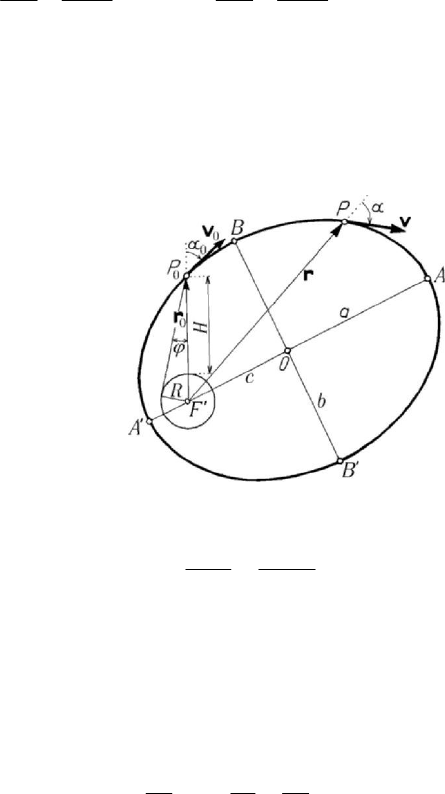
MECHANICAL SYSTEMS, CLASSICAL MODELS
578
2.2.1 Theory of artificial satellites of the Earth. Conditions to become a satellite
The general theory presented in Subsec. 2.1.2 may be used to study the launching
and the motion of the artificial satellites of the Earth. To this goal, we assume that the
Earth is a sphere of radius
R , its mass being distributed with spherical geometry. If M
is the mass of the Earth, in conformity with the formula (1.1.85) we may write
2
f
MgR= . In this case, the conservation theorem of mechanical energy takes the form
22
2
mv mgR
h
r
−=
,
2
2
0
0
2
mv
mgR
h
r
=−
,
0
rRH
=
+ ;
(9.2.32)
we assume that the satellite
P , modelled as a particle of mass m , is unbound from the
launching rocket at the height
H from Earth’s surface, along the local vertical, at the
point
0
P of position vector
0
r , the initial velocity being
0
v (Fig.9.13). To obtain thus a
satellite of the Earth, the trajectory of the particle
P must be an ellipse; in this case
0h < , so that the initial velocity fulfils the condition
Figure 9.13. Launching of an artificial satellite of the Earth.
22
2
0
0
22gR gR
v
rRH
<=
+
.
(9.2.33)
The particle
P becomes a satellite if, supplementary, the distance to the perigee is at
least equal to the radius of the Earth (
min
rR≥ ). Taking into account the results in
Subsec. 2.1.3, we must have
(1 )aeR
−
≥ , wherefrom 1/eRa
≤
− . Because 0e ≥ ,
one must have
aR≥ too; associating the inequality (9.2.33) to (9.2.12'''), we have
finally,
2
0
00
22
1
v
RR
rgRr
−≤ <
,
(9.2.33')
obtaining thus inferior and superior limits for the initial velocity.

Newtonian theory of universal attraction
579
Taking into account the first relation (9.2.12'), we may express the condition
(1 )aeR−≥ in the form /(1 )peR
+
≥ or /1pR e
−
≥ too; the first inequality
(9.2.33') ensures that
pR≥
(because, in this case 0e ≥ ), so that we may also write
()
2
2
/1pR e−≥. The first relation (9.2.7') leads to
(
)
2
2
2
2
0
2
0
0
11cot
ppp
Rr
r
α
⎛⎞
−≥ −+
⎜⎟
⎝⎠
;
using the relation (9.2.7), we get then
222
00 0
22
0
sin
11
1
2
vr
Rr
gR R
α
⎛⎞
−≥−
⎜⎟
⎝⎠
.
(9.2.34)
Because
0
1/ 1/Rr≥ , it results that we must have
22 2
00
sinrRα ≥ too, wherefrom
00
sinrRα ≥ ; (9.2.34')
this relation states that the support of the velocity
0
v cannot pierce the Earth’s sphere
(at the limit, it may be tangent to it (Fig.9.12)). We notice that the relation
()
2
0
22 2
0
00 0
2( )
2
1
sin
Rr R
R
r
rr Rα
−
≥−
−
takes place; indeed, bringing to the same denominator, we read
2
00 00 0
( sin ) 2 sin (1 sin ) 0Rr Rrααα−+ −≥
.
The equality can take place only in case of a launching from the surface of the Earth,
tangent to it. From (9.2.33')-(9.2.34') it results
2
0
0
0
22 2
00
00
()
sin
2
sin
Rr R
v
RR
rgRr
rR
α
α
−
≤<≤
−
,
(9.2.35)
in this case. These inequalities represent the conditions to become a satellite; the first
and the last inequality correspond to the non-returning on the Earth (to the escape from
the Earth), while the second inequality corresponds to the transformation of the body
launched from the surface of the Earth in a satellite of that one (elliptic trajectory).
If the satellite enters on the orbit under an incidence angle
0
/2απ
=
, then the
conditions (9.2.35) become (the last inequality is verified because
0
Rr
≤
)
2
0
00 0
2
v
RR R
rR r gR r
≤<
+
,
(9.2.35')
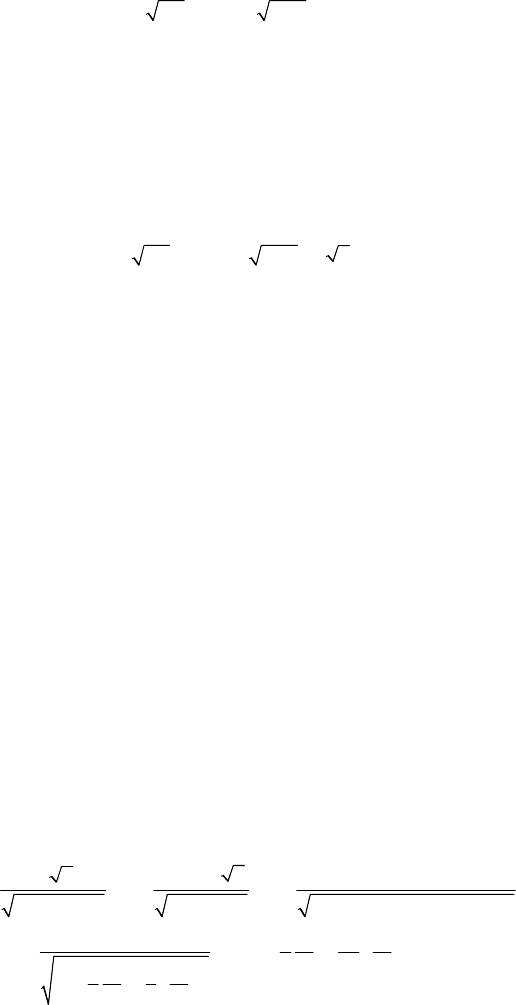
MECHANICAL SYSTEMS, CLASSICAL MODELS
580
while in the case in which
0H
≅
, hence
0
rR
≅
(the launching point is very close to
the surface of the Earth), we get
0
2gR v gR≤< .
(9.2.35'')
2.2.2 Cosmic velocities
The inequalities (9.2.35'') may be written in the form
0
III
vvv
≤
< , (9.2.36)
where we have introduced the first and the second cosmic velocities, respectively, given
by
I
vgR= ,
II I
22vgRv==;
(9.2.37)
taking
2
9.81 m/sg = and
6
6.38 10 mR =⋅ , we get
I
7.905 km/sv
=
and
II
11.179 km/sv = .
In general, the velocities for which a terrestrial body becomes a celestial one are
called cosmic velocities. The two velocities put here in evidence are called special
cosmic velocities. The first special cosmic velocity (the circular cosmic velocity)
represents the smallest velocity by which a body can be launched from the surface of
the Earth (tangent to it) without returning on the Earth; the second special cosmic
velocity (the parabolic cosmic velocity) is the greatest velocity by which a body may be
launched from the surface of the Earth so that to remain a satellite of it. Any cosmic
velocity contained between the two mentioned velocities leads to an elliptic trajectory.
A cosmic velocity equal to
II
v leads to a parabolic trajectory, while a cosmic velocity
greater than
II
v leads to a hyperbolic one. In the latter cases, the celestial body so
created can no more be a satellite of the Earth, having a non-bounded trajectory in the
interplanetary space; eventually, it can be captured by another celestial body in the
proximity of which may pass its trajectory.
The numerical results thus obtained have a certain degree of approximation; indeed,
we should take into account the whole system of particles which are involved in motion
(see Chap. 11 too), as well as the resistance of the atmosphere (on a trajectory of
200-300 km , till the satellite enters in the interplanetary space, where the resistance of
the air is negligible). In this order of ideas, if the entrance on the trajectory takes place
at a height
H (measured along the local vertical), then the conditions (9.2.35') lead to
(9.2.36) too, in the form
0
III
HH
vvv≤<, with
0
I
III
00 0
(/)2
2
( ) 1 / (1 / )(1 /2 )
H
Rr
v
R
vvv
rRrRrHRHR
===
++ ++
()
(
)
2
I
I
2
319
1
432
31
1
22
v
HH
v
RR
HH
RR
⎡
⎤
=≅−+
⎢
⎥
⎣
⎦
++
,
(9.2.37')
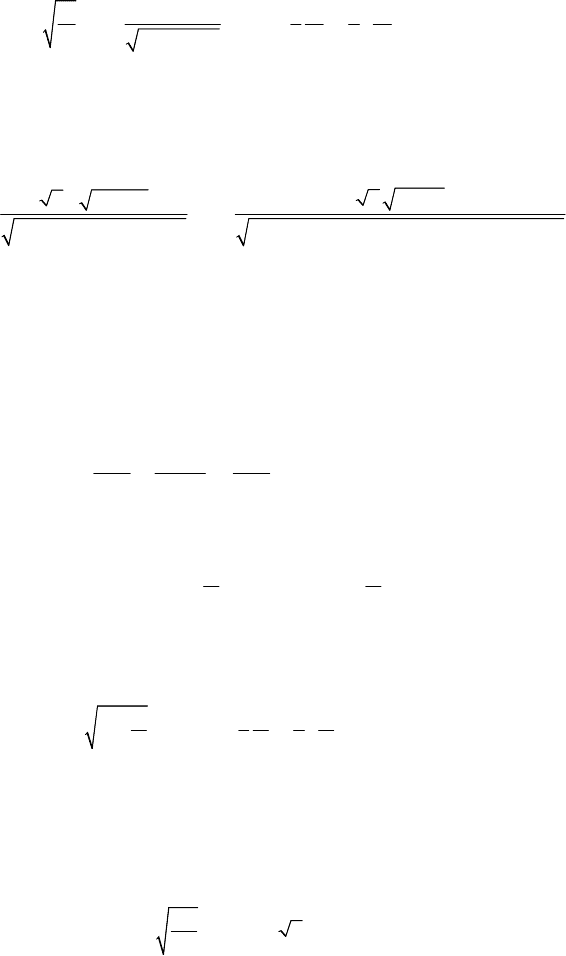
Newtonian theory of universal attraction
581
(
)
2
II
II II II
0
13
1
28
1/
H
v
RHH
vv v
rRR
HR
⎡
⎤
== ≅−+
⎢
⎥
+
⎣
⎦
.
(9.2.37'')
Taking, e.g.,
5
210 mH =⋅ , we get
II
(1 0.02355 0.00059)
H
vv=− +
I
0.977v≅
7.723 km/s= and
II II
(1 0.01570 0.00037)
H
vv=− +
II
0.985v
≅
11.011 km/s= ,
hence velocities somewhat smaller. In general, we should take
()
0
II I
22 2
22
00 0
0
2/
2
sin
(1 / ) (1 / ) sin 1
H
HR
Rr R
vv v
rr R
HR HR
α
α
−
==
−
++ −
⎡
⎤
⎣
⎦
;
(9.2.37''')
obviously, the angle
0
α cannot be chosen arbitrarily, because the quantity under the
radical sign must be positive.
Returning to the conservation theorem of mechanical energy (9.2.32) and assuming
that a body (modelled as a particle) is launched from the Earth surface (
0
rR= ), we
may write
2
22
0
22
mv
mv mgR
mgR
r
−=−
;
(9.2.38)
it results
(
)
(
)
22 22
00
II
21 1
RR
vv gR vv
rr
=− − =− − .
(9.2.38')
A particle can reach the point
P , at a distance r from the centre of the Earth
(Fig.9.13), with a velocity
0v
≠
, only if
(
)
2
0
II II
11
11
28
RRR
vv v
rrr
⎡
⎤
≥− ≅− +
⎢
⎥
⎣
⎦
.
(9.2.39)
For instance, if
60rR= (the distance from the centre of the Earth to the centre of the
Moon), then we obtain
0
II
(1 0.00833 0.00003)vv≥− +
II
0.992 11.090 km/sv
≅
= .
In general, the cosmic velocities corresponding to an arbitrary celestial body, of mass
m , are given by
0
I
0
r
f
m
v
r
=
,
00
II I
2
rr
vv= ,
(9.2.40)
where
0
r is the distance from the interplanetary vehicle to the centre of the considered
celestial body. These formulae are useful to establish the conditions in which a body
which is launched from the Earth surface and reaches a certain distance from another
celestial body (Moon, Sun etc.) becomes a satellite of that one or continues its
